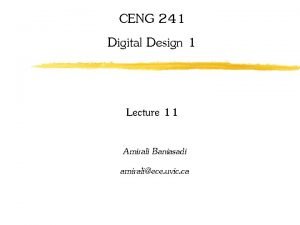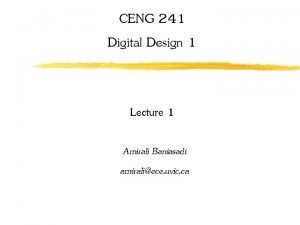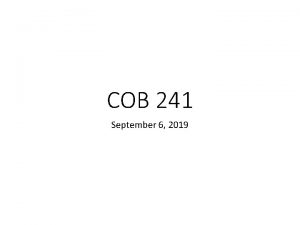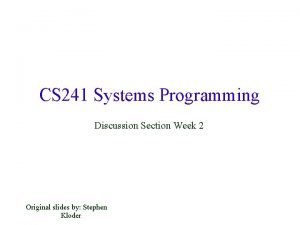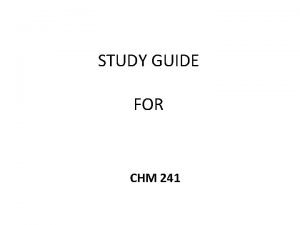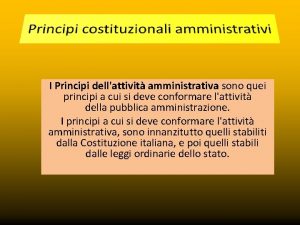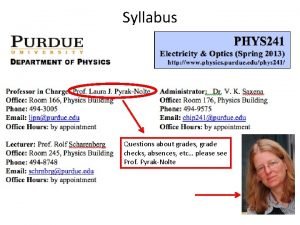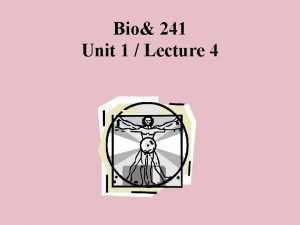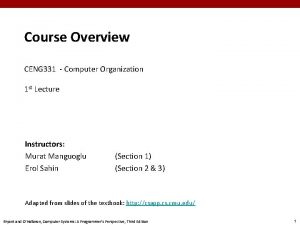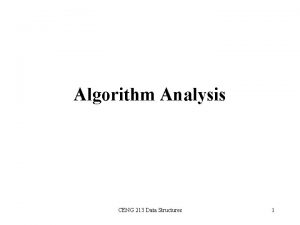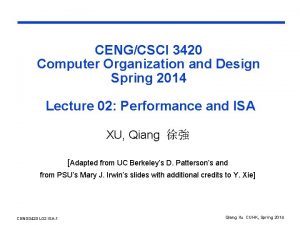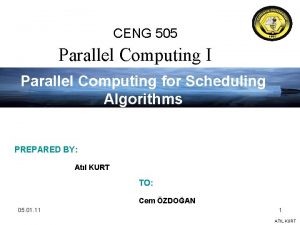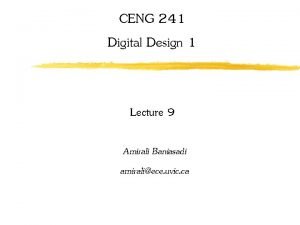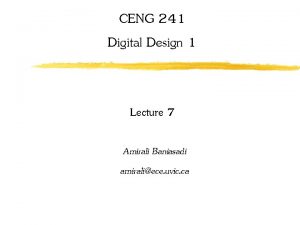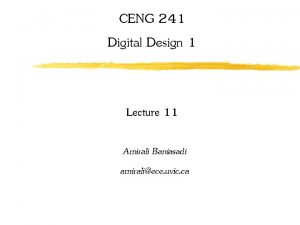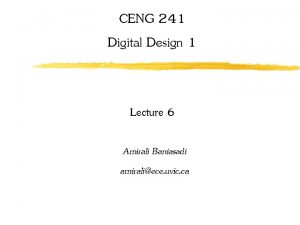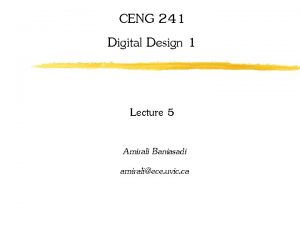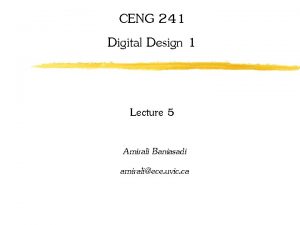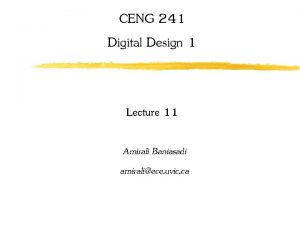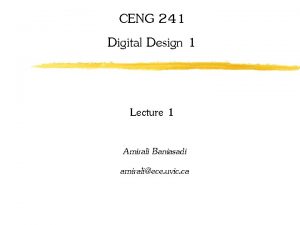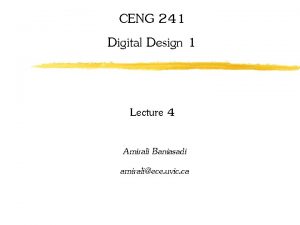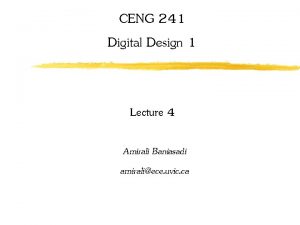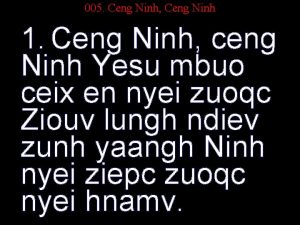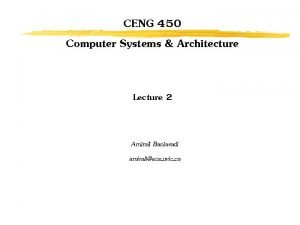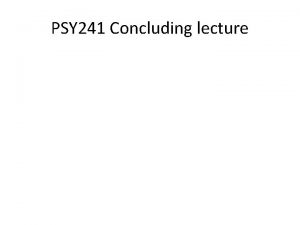CENG 241 Digital Design 1 Lecture 10 Amirali






























- Slides: 30

CENG 241 Digital Design 1 Lecture 10 Amirali Baniasadi amirali@ece. uvic. ca

This Lecture z Review of last lecture: Analysis z Chapter 5: State Reduction, Design Procedure 2

Analysis of Clocked Sequential Circuits z Analysis: Obtaining a table/diagram for the time sequence of inputs/outputs/internal states. z Examples: State Equations, State Table, State Diagram 3

Analysis of Clocked Sequential Circuits Example of state equation: A(t+1) = A(t)x(t) + B(t)x(t) B(t+1) = A’(t)x(t) A(t+1)=Ax+Bx B(t+1)=A’x y(t)=(A(t)+B(t)). x’(t) = (A+B)x’ 4

Example of state tables z z z z z Present A 0 0 1 1 state B 0 0 1 1 input x 0 1 0 1 Next State A B 0 0 0 1 1 0 0 0 1 0 Output y 0 0 1 0 1 0 State equation: A(t+1) = A(t)x(t) + B(t)x(t) B(t+1) = A’(t)x(t) y(t)=(A(t)+B(t)). x’(t) 5

Example of state tables-2 nd form z z z z Present state AB 00 01 10 11 Next State x=0 x=1 AB AB 00 01 00 10 Output x=0 x=1 y y 0 0 1 0 1 0 State equation: A(t+1) = A(t)x(t) + B(t)x(t) B(t+1) = A’(t)x(t) y(t)=(A(t)+B(t)). x’(t) 6

Example of state diagram Present state AB 00 01 10 11 Next State x=0 x=1 AB AB 00 01 00 10 Output x=0 x=1 y y 0 0 1 0 1 0 7

Mealy & Moore z Mealy machine: Output depends on both input & present state z Moore machine: Output only depends on present state. 8

Example of Mealy Machine Present state AB 00 01 10 11 Next State x=0 x=1 AB AB 00 01 00 10 Output x=0 x=1 y y 0 0 1 0 1 0 9

Example of Moore Machine Present state A B 0 0 0 1 0 1 1 1 1 input x 0 1 0 1 Next State A B 0 1 0 0 1 1 1 0 0 0 1 1 10

State Reduction and Assignment z Goal: Reduce the number of states while keeping the external input-output requirements. z 2 m states need m flip-flops, so reducing the states may reduce flip-flops. z If two states are equal, one can be removed but what are equal states? 11

State Reduction Example As an example consider the input sequence below: 010101110100 applied and start from state a. State input output a a b c d e f f g 0 1 0 1 1 0 0 0 0 1 1 0 0 a 12

State Reduction Example Present State a b c d e f g Next State x=0 x=1 Output x=0 x=1 a c a e a g a 0 0 0 0 b d d f f 0 0 0 1 1 States e and g are equal since for each member of the set of inputs, they give the same output and send the circuit either to the same state or an equivalent state. 13

State Reduction Example Present State a b c d e f Next State x=0 x=1 Output x=0 x=1 a c a e 0 0 0 b d d f f f 0 0 0 1 1 1 NEW equal states: d and f Table and state diagram after the first reduction: g is removed and replaced by state e. 14

State Reduction Example Present State a b c d e Next State x=0 x=1 Output x=0 x=1 a c a e a 0 0 0 b d d 0 0 0 1 1 If we apply the same sequence State input output a a b c d e d e 0 1 0 1 1 0 0 0 0 1 1 0 0 a Table and state diagram after the second reduction: f is removed and replaced by state d. 15

Design Procedure First Step: From the word description of the problem derive a state diagram example: design a circuit to detect three or more consecutive 1’s in a string of bits coming through an input line. 16

Design steps z z z z 1. From word description, derive state diagram 2. Reduce the number of states 3. Assign binary values to states 4. Obtain the binary coded state table 5. Choose the type of flip-flop used 6. Derive the simplified flip-flop input and output equations 7. Draw the logic diagram z steps 4 to 7 can be implemented by exact algorithms and can be automated. z The part of the design that is well-defined is referred to as synthesis. 17

State Table for Sequence Decoder z z z z z Present State A B 0 0 0 1 0 1 1 1 1 Input x 0 1 0 1 Next State A B 0 0 0 1 1 Output y 0 0 0 1 1 A(t+1)= Σ(3, 5, 7) B(t+1)= Σ(1, 5, 7) Y(A, B, x)= Σ(6, 7) 18

Synthesis Using D Flip-Flops A(t+1)=DA(A, B, x)= Σ(3, 5, 7) B(t+1)=DB(A, B, x)= Σ(1, 5, 7) Y(A, B, x)= Σ(6, 7) 19

Logic Diagram for a Sequence Detector DA = Ax + Bx DB= Ax + B’x y=AB 20

Excitation Tables z Using flip-flops other than D can be complicated. z Why? Input equations for the circuit must be derived indirectly from the state table z Excitation tables can help. z Excitation tables give us the flip-flop input for every state transition. z z z Example : JK- Recall Q(t+1) = JQ’(t) + K’Q(t) Q(t+1) J K 0 0 0 X 0 1 1 X 1 0 X 1 1 1 X 0 21

Excitation Tables- T flip-flop z z z Example : JK- Recall Q(t+1) = TQ’(t) + T’Q(t) = T XOR Q Q(t) Q(t+1) T 0 0 1 1 1 0 22

Synthesis Using JK Flip-Flops z z z z z Present State A B 0 0 0 1 0 1 1 1 1 Input x 0 1 0 1 Next State A B 0 0 0 1 1 JA 0 0 1 0 x x Flip-Flop Inputs KA JB x 0 x 1 x x 0 0 0 1 0 x 1 x KB x x 1 0 x x 0 1 z We also include J, K input conditions, derived from the excitation table. 23

Synthesis Using JK Flip-Flops 24

Synthesis Using JK Flip-Flops 25

Synthesis Using T Flip-Flops Example: 3 -bit Binary Counter The counter counts the clock. Clock does not appear explicitly in the state diagram. 26

Synthesis Using T Flip-Flops Present State A 2 A 1 A 0 0 0 1 1 1 0 0 1 1 1 A 2 0 0 0 1 1 0 Next State A 1 A 0 0 1 1 0 0 Flip-Flop Inputs TA 2 TA 1 TA 0 0 0 1 0 1 1 0 0 1 1 1 1 27

Synthesis Using T Flip-Flops 28

Synthesis Using T Flip-Flops 29

Summary z State Reduction, Synthesis 30
 Ceng 241
Ceng 241 Ceng 241
Ceng 241 Phys 241 lecture quizzes
Phys 241 lecture quizzes 01:640:244 lecture notes - lecture 15: plat, idah, farad
01:640:244 lecture notes - lecture 15: plat, idah, farad Nfpa 241 requirements
Nfpa 241 requirements 241 bce
241 bce Round 625 to the nearest hundred
Round 625 to the nearest hundred Fon 241
Fon 241 Cob 241
Cob 241 Psyco 241
Psyco 241 Cs 241 vector mp
Cs 241 vector mp Chm 241
Chm 241 Detail drawing example
Detail drawing example Legge 241/90 slide
Legge 241/90 slide Vectoral
Vectoral Legge 241/90 slide
Legge 241/90 slide Purdue phys 241
Purdue phys 241 Bio 241
Bio 241 241 in arabic
241 in arabic Emine ceng
Emine ceng Ceng 考牌
Ceng 考牌 Cow ceng metu
Cow ceng metu Imeche ceng application form
Imeche ceng application form Ceng 334
Ceng 334 Cow ceng
Cow ceng Koü ceng
Koü ceng Citp vs ceng
Citp vs ceng Ceng 213
Ceng 213 Ceng 291
Ceng 291 Ceng3420
Ceng3420 505
505
